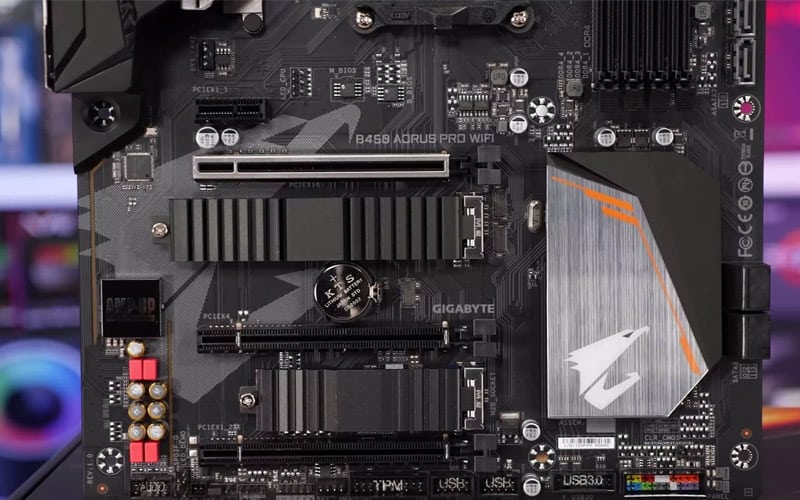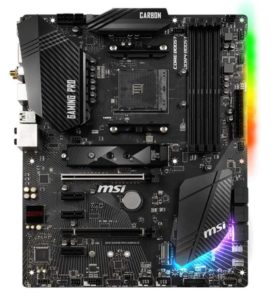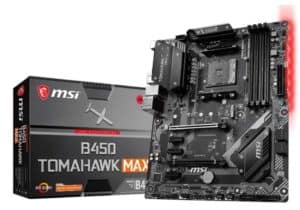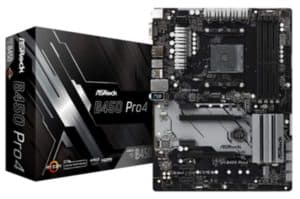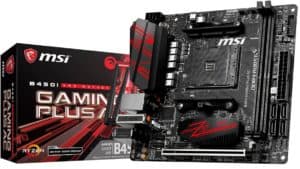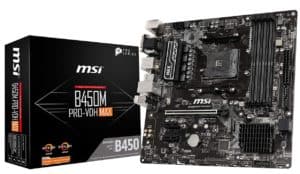Products at a Glance
How we picked
To choose the best motherboards for our Ryzen 5 2600 processors, we began by confirming socket compatibility (AM4) and determining the form factors that suited our builds (ATX, micro ATX, or mini ITX). We opted for chipsets like B450 or B550 for a balanced feature-to-price ratio, but considered X470 or X570 for high-end features and PCIe 4.0 support. We prioritized motherboards with robust VRM designs as we planned to overclock our CPUs and checked for RAM compatibility and support for faster RAM speeds.
Additionally, we assessed the number of PCIe slots, connectivity options, and audio quality based on our specific needs. We made sure to choose motherboards from reputable brands and models with positive reviews and reliable customer support. We considered models across a range of budgets, and tried to keep future-proofing in mind by selecting boards that supported newer Ryzen processors if we planned to upgrade.
Product Reviews
- Price - It may be cheap compared to X470, but not among its own kind.
Featuring AMD’s fantastic B450 chipset, even just on the surface, this motherboard is a shoo-in for your 2600 build, but when you look a little closer, you realize just how amazing it really is.
Loaded with beefy carbon fiber heatsinks, 6 fan headers, and a juicy 8+2 power phase VRM, this thing is an overclocker’s dream, the cool-running power design ensuring a stable CPU voltage as you push your R5 2600 beyond its factory limits.
The Carbon AC’s memory configuration doesn’t disappoint either. Capable of running a maximum of 64GB DDR4 RAM at 3466MHz, day-to-day computational tasks run silky smooth. What’s more, it’s XMP compatible, meaning you can boost your RAM alongside your CPU for some epic performance gains, making it one of the best motherboards for gaming too.
Boasting both integrated wifi 5 and gigabit LAN Ethernet, you’re afforded both freedom to roam from your router and, if need be, a superfast, reliable connection.
This is a board that punches well above its weight without breaking a sweat. It’s a little pricey for a B450, but it really is the best of the best.
- 64GB 2466 DDR4 RAM - Makes for a highly efficient system.
- Great VRM Cooling - Takes overclocks exceedingly well.
- GB LAN - Uber fast network connection.
- Price - Not cheap but more reasonable than the Carbon.
- No Wifi - We’re afraid it’s all LAN.
- Audio Quality - Not quite as good as the Carbon.
If you liked the sound of the Carbon AC, but it’s a little too rich for your blood, the Tomahawk is the natural alternative. A little less feature-dense than the Carbon, it still has all the essentials for making the most out of your R5 2600, one of them being its RAM capacity.
This monstrous motherboard can make full use of 64GB 2466 DDR4 memory, but if that doesn’t quite float your boat, why not open the frequency strap selector and push capacity to 4200MHz.
While the heat sink isn’t quite as impressive as the Carbon due to the lack of, well…carbon, the 4+2 power design still lends itself incredibly well to some OC wizardry. With a quality fan curve, there’s no reason you can’t push your R5 2600 well beyond stock settings.
Honestly, besides having a slightly diminished audio capacity, the only real issue we found with the Tomahawk is that it doesn’t have wifi, but while you may be anchored to your router, the gigabit LAN ensures you always have a solid connection.
The beauty of this board isn’t found in raw power, rather in the balance of design and abilities that let the Ryzen 5 2600 shine.
- 10-Phase VRM - Epic overclock potential.
- 64GB DDR4 - 3200 - Can be boosted to run incredibly fast RAM.
- Quad CrossFire - Potential to run four GPUs simultaneously.
- Gigabit LAN - lightning-fast network connection.
- Audio Quality - Not bad, but could be better.
- No Wifi - Ethernet cables at the ready!
Capable of supporting 64GB of DDR4 RAM up to speeds of 2400MHz, the Pro4 makes an excellent platform for a super-efficient Ryzen 5 2600 build. Plus, you can boost its memory speed capacity to 3200Mhz with a spot of overclocking.
Speaking of, this beast has a 10-phase power design, and the heatsink is relatively proficient too, meaning you can overclock your 2600 for some high frame rate 1440p or 4K gaming.
In terms of audio, you get the Realtek ALC892 as opposed to the more impressive ALC 1220, but it still has plenty of sonic clout, helping to create an immersive gaming experience or simply do your favorite tunes justice.
There’s no wifi on this board, which may be a dealbreaker for some, but check the price on this thing; we’ll wait…amazing, right? And though it may lack wireless connectivity, it does have a gigabit LAN Ethernet port, so your connection speed will be second to none.
The ASRock Pro4 also features AMD Quad CrossFire, a technology that enables you to use four GPUs simultaneously. There’s absolutely no need to do this with something like the R5 2600, but it’s a cool feature nonetheless, one that illustrates the true power of this budget board.
- 8-Phase Power Design - Capable of some mild OC-ing.
- 32GB DDR4 - 3466 - This boosted rate makes for an incredibly efficient system.
- Gigabit LAN - Great upload and download speeds.
- No Wifi - You’ll have to add an adapter if you want to make cables a thing of the past.
Coming in at our penultimate spot, we have our first Mini ITX motherboard, the MSI B450I Gaming Plus. Little it may be, it still packs a serious punch. Take the memory capacity for example. After a little tweaking with XMP, it can support 32GB of DDR4 memory up to 3466MHz. That’s enough for any application short of intensive image and video editing.
The VRM is made up of an 8-phase system in a 6+2 configuration. Match it with some quality cooling, and you should have no problem supplementing performance with some mild overclocks.
It doesn’t feature wifi connectivity, which is a definite downside, but if it means that much to you, you can fork out another $10 for the Gaming Plus Max Wifi, otherwise, the gigabit LAN should keep you happy.
If you’ve been dreaming of a discrete SFF build, the Gaming Plus is undoubtedly the best option available. Some may be put off by the price tag that doesn’t scale with the size, but Mini ITX boards often cost more due to their scarcity.
- 64GB DDR4 - 3466 - We’ve even heard rumors a solid OC will break 4000MHz.
- Gigabit LAN - Never lose connection mid-game.
- Neutral Aesthetics - Will fit tastefully into an SFF case.
- Price - Your bank account will barely feel it.
- PCI-e 3 - No PCI-e 4 means reduced bandwidth communication between components.
Our final magical Ryzen 5 2600 motherboard is nothing short of a Micro ATX masterpiece. Capable of supporting 64GB of DDR4 – 2133MHz memory spread across the four expansion slots, it’s an incredibly low latency system with snappy load and boot times and swift file operation. In addition, if you need the odd boost for some high-resolution gaming, it can handle speeds up to 3466Mhz.
It’s a budget board, so it doesn’t have wifi connectivity, but of course, it has the next best thing, gigabit LAN. In fact, the stability and speed of LAN is a much more sensible option for things that require a steady connection like online multiplayer gaming or content creation workflows.
PCI-e 4 support in B450 boards is fairly limited anyway, but unfortunately, the ProVDH doesn’t have any PCI-e 4 ports whatsoever. Realistically, though, this isn’t going to have much of an effect on day-to-day performance other than a slightly larger energy requirement, which is already offset by the smaller form factor.
Aesthetically, it’s a very neutral, tasteful board. Well, we mean…it still looks like a bird’s-eye view of a nuclear power plant, but a slick, futuristic one. It’s made of tough stuff too, evidenced by the reinforced graphics slot, so even though it’s a diminutive design, it’s not scared to be twinned with beefy peripherals.
Things To Consider
Form Factor
Before we get to the technical stuff, we’ll need to consider what size motherboard you’re after. There are currently four main form factors available…
ATX (12 x 9.6”) – This is considered the standard size motherboard. It will fit in most mid-tower cases and can have as many as seven expansion slots.
Micro ATX (9.6 x 9.6”) – These motherboards are usually square-shaped and are often used for compact builds. They can have as many as four expansion slots and are backward compatible with ATX cases.
Mini ITX (6.7 x 6.7”) – Even smaller still, we have the Mini ITX form factor motherboard. These are used for incredibly SFF builds, but much like the Micro ATX, will be fully supported in an ATX case.
EATX (12 x 13”) – On the other end of the spectrum, we have the largest form factor, the EATX. It’s unlikely you’ll be considering this as they’re usually only used for incredibly powerful builds with dual CPUs.
Socket and Chipset
Next on the agenda is the socket. You’ll need an AM4 motherboard, and being that AM4 has been AMD’s one-stop socket for all their processors since 2016, they’re not hard to find.
Your Ryzen 5 2600 is compatible with eight different AMD chipsets, but as you’ve seen from our list, we highly recommend only one, the B450. It offers you just the right amount of power to eke out every last drop of performance from your Ryzen processor.
B450 isn’t the highest performing chipset, but anything from the top-tier X-Series motherboards is widely considered to be overkill for the Ryzen 5 2600.
Wi-Fi
Do you want your motherboard to connect up to your network wirelessly? It’s a really great feature, but unfortunately, it’s not a universal one, so be wary when making your decision. Motherboards without integrated wifi connectivity rely on a LAN Ethernet connection.
Lan Ethernet
In the absence of wifi, you should take stock of LAN proficiency. Ethernet connections come with vastly different bandwidths, so it makes sense to shop around for the best one. Ideally, your motherboard will feature gigabit LAN, a port capable of 1000MBps transfer speeds.
Power Design
The power design of your motherboard refers to the VRM (voltage regulator module). It’s the VRM that transforms the power from your outlet into energy suitable for powering your CPU.
What’s the VRM made up of? Power phases. What are power phases? A basic power phase is a mechanism made up of a capacitor, two transistors, and a choke. Component quality does come into play in a big way but generally speaking, the more power phases your motherboard has, the more stable the CPU voltage becomes.
This is because the more power phases there are, the less each one has to work. The burden never falls too heavily on any of them, enabling them to work cooler. In light of this, if you’re interested in overclocking your Ryzen 5 2600, we recommend a more expansive power design or at least one that uses high-quality components.
Memory Speed
We know what you’re thinking…motherboards don’t come with RAM, right? Well, no, unless you got some kind of sweet, all-inclusive, second-hand deal, motherboards don’t come with any integrated or additional memory. They do; however, come with memory capacities.
That’s right, folks. You can’t just load your motherboard up with any old RAM. It can only support a certain memory capacity and speed. If you do try and use more or faster RAM than your board is designed to utilize, it simply won’t do anything with the excess, and you’ll have wasted your money.
What is the Best Motherboard for Ryzen 5 2600?
In our expert opinion, it’s the MSI B450 Gaming Pro Carbon AC.
Is an X470 Motherboard Worth it for Ryzen 5 2600?
The X470 chipset is a little OP for the Ryzen 5 2600. That kind of chipset is geared towards higher power builds and extreme overclocks.
Is the Ryzen 5 2600 Good for Gaming?
The Ryzen 5 2600 is fantastic for gaming. With six multi-threaded cores, it’s capable of supporting 1440p or even 4K gaming. Teamed with a quality graphics card, there’s very little it’s not capable of.
What’s the Difference Between B450 and B450M Motherboards?
There’s not much of a difference between B450 and B45M motherboards to talk about besides form factor. The key thing to remember is that they have different video ports. For instance, the B450 uses DisplayPort outputs, while the B450M has DVI-D ports.
Is PCI-e 4 Worth it with a B450 Chipset?
PCI-e 4 offers a solid boost in data transfer between your main and peripheral components, but it often does significantly bump the price up on a motherboard. Whether the price is equal to or outweighs the benefits depends on what you want your build to be capable of. If you’re looking to make your R5 2600 build as powerful as possible, PCI-e 4 is the only way to go. If not, the gains are definitely not worth it.
Our Verdict
That’s all we have for you today. Did you see your Ryzen 5 2600’s new home on our list? We think there’s something there for everyone. The MSI Carbon is our premium option for those who want to really put that Ryzen CPU to the test. Mind you, the Tomahawk and ASRock boards are also highly capable and probably make the best match for the 2600.
Then we have our two diminutive dynamos, the B450I and the B450M. These motherboards prove that bigger isn’t always better, and if you can harness the power of a hefty ATX build in something energy-efficient, lightweight, and aesthetically pleasing, why wouldn’t you?

